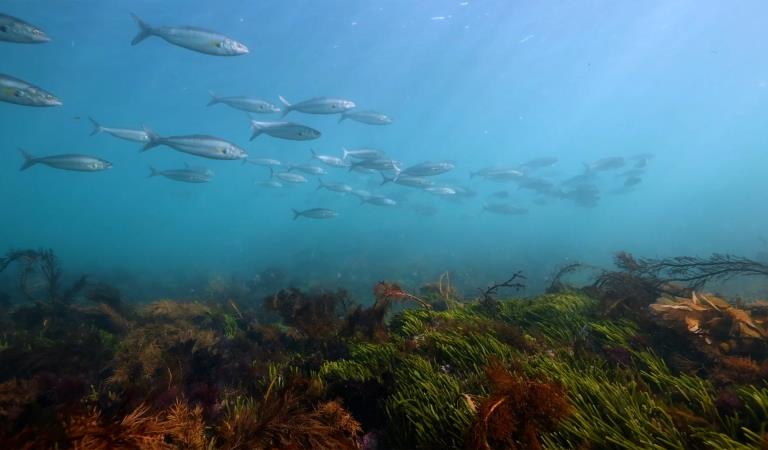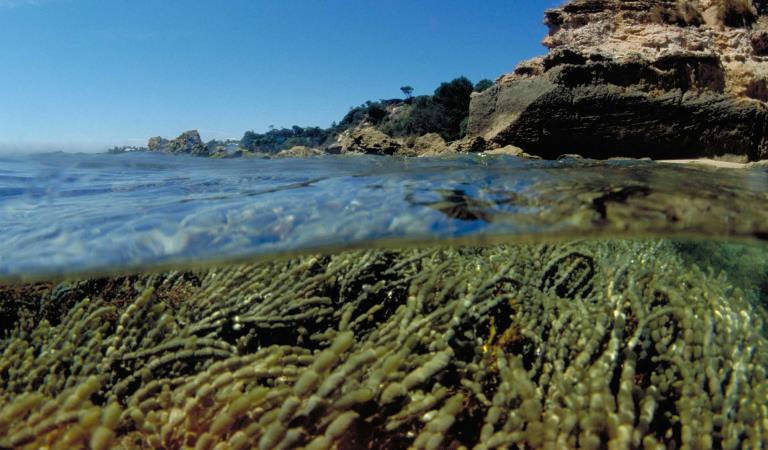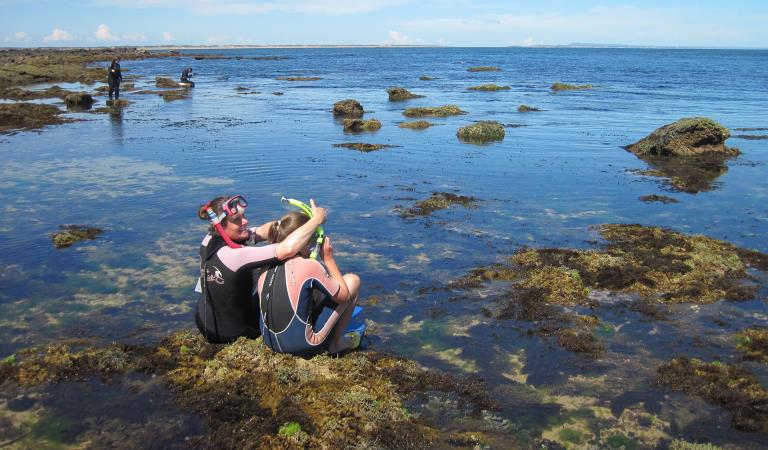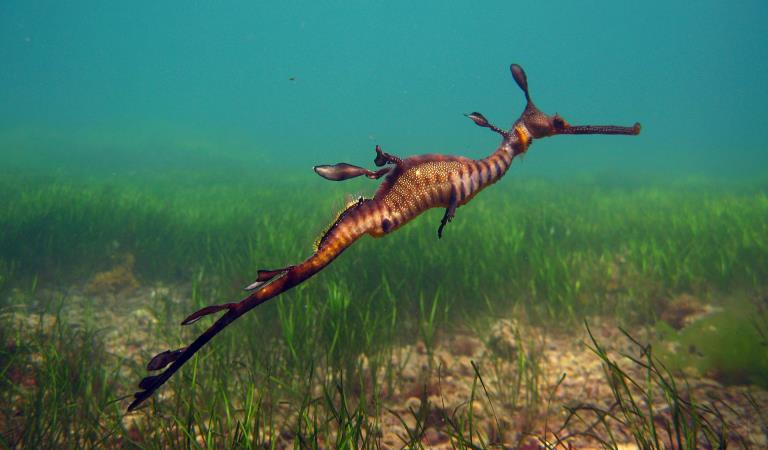Marine
The marine ecosystem is the largest aquatic ecosystem on Earth, distinguished by water with a high salt content.
A useful way to differentiate and manage the marine ecosystem is by marine habitats and the animals and plants typical of these areas. A marine habitat is a place where species are found together.
Habitats provide energy or food sources, oxygen, water, protection and opportunities for reproduction - all the basic needs for marine organisms to survive.
While marine habitats may occur in different locations within a marine national park, marine sanctuary or along the coast, they often have similar species, values and are affected by similar threats.
Key threats to marine habitats
- Visitors removing or trampling animals and plants, including fishing
- Climate change effects including sea level rise, warming sea surface temperatures and increasing ocean acidity
- Large numbers of over-abundant grazers such as native sea urchins
- Poor water quality entering the sea from catchments
- Boat and anchor damage in shallow areas
- Oil and chemical pollution
- Marine pests which compete for food or space including the Northern Pacific Seastar (Asterias amurensis), Japanese Kelp (Undaria pinnatifida), European Green Crab (Carcinus meanus) and Broccoli Weed (Codium fragile ssp. tomentosoides).
Rocky reefs
Subtidal
As the name suggests, subtidal rocky reefs are composed of rocks (e.g. granite, limestone, basalt) which are always submerged, even at low tide. Found in both deep and shallow waters, they provide an essential, solid foundation which many plants and animals need to survive. Erosion from wave action can create rock overhangs and crevices which provide shelter and protection to the species which live there.
Subtidal rocky reefs are home to a fascinating and diverse range of marine plants and animals. Shallower reefs can support extensive plant communities forming kelp forests whereas deeper communities can be brilliantly coloured due to the huge diversity of sponges and marine invertebrates. Even though Victorian reefs are temperate, bright corals are common in many areas as well as magnificent fish.
The reefs are vital to the survival of many species, including commercially viable species such as abalone and rock lobsters. They also provide an excellent site for divers and snorkellers to experience a huge range of Victoria’s marine life.
You can visit subtidal rocky reefs in the following places:
- Wilsons Promontory Marine National Park
- Bunurong Marine National Park
- Ricketts Point Marine Sanctuary
- Jawbone Marine Sanctuary
- Point Cooke Marine Sanctuary
- Barwon Bluff Marine Sanctuary
Intertidal
Rocky reefs that are exposed at low tide are great places to explore as there are many animals and several plants that can survive out of the water for some time. These rocky shore communities are quite variable across Victoria. Intertidal communities differ depending on the level of exposure to waves, the rock type and its weathering, the presence of rockpools, crevices, and boulders, and the presence or absence of predators.
Animals found on rocky reefs include Shore crabs (Paragrapsus quadridentatus), Common Seastar (Meridiastra calcar), Blue Periwinkle (Nodolittorina unifasciata) and Smooth Limpet (Cellana tramoserica). Neptune’s Necklace (Homosira banksii) is a common plant found in this habitat.
You can visit intertidal rocky reefs in the following places:
- Point Hicks Marine National Park
- Port Phillip Heads Marine National Park
- Point Addis Marine National Park
- Mushroom Reef Marine Sanctuary
- Marengo Reefs Marine Sanctuary
- Merri Marine Sanctuary
Sponge Gardens
Brightly coloured and composed of a huge range of invertebrate species, sponge gardens are found growing on deep reefs (generally greater than 20m) along the coast of Victoria. These habitats flourish in deeper waters or shaded areas because they do not require much light, unlike algae and seagrass.
The invertebrates which make up the fascinating ecosystem include sponges, hydroids, sea fans, sea whips, sea pens, tube worms, bryozoans and ascidians. These, in turn, provide an important habitat for other animals (e.g. nudibranchs).They are generally filter feeders, which means that they filter small particles out of the water column for food. Sponge gardens play an essential role in nutrient cycling in the ocean.
You can visit sponge gardens in the following places:
- Wilsons Promontory Marine National Park
- Port Phillip Heads Marine National Park
- Bunurong Marine National Park
- Twelve Apostles Marine National Park
- The Arches Marine Sanctuary
- Beware Reef Marine Sanctuary
Kelp forests
Seaweed forests are made up of a special group of large brown algae called kelps. These large plants attach themselves to solid structures such as rock and extend their blades into the waters reaching towards the sunlight.
These large algae forests create habitat for smaller algae and a wealth of animals that either live attached to the rocks beneath the kelps, on the kelps themselves or in the sheltered waters between individual plants.
In the same way that trees provide shelter and food for many different species, kelp forests are the forests of the sea. The kelp forest has a dense canopy of blades blocking out light and shading the surface of the rock. This provides an ideal environment for smaller algae and non-moving animals.
Kelp species populating these forests include Giant Kelp (Macrocystis angustifolia) and Bull Kelp (Durvillea potatorum). Animals that make their home in kelp forests are Eastern Rock Lobster (Jasus edwardii), Black Lipped Abalone (Haliotis rubra) and Old Wife (Enoplosus armatus).
You can visit kelp forests in the following locations:
- Discovery Bay Marine National Park
- Beware Reef Marine Sanctuary
- Point Cooke Marine Sanctuary
- Barwon Bluff Marine Sanctuary
- Eagle Rock Marine Sanctuary
- Twelve Apostles Marine National Park
Mangroves
In sheltered bays and inlets like Western Port and Corner Inlet, and larger estuaries like the Yarra and Barwon Rivers, small trees called mangroves form an important protective fringe along the coastline and out into the water. Mangroves provide important protection for coastlines from the erosion caused by waves and storms.
The White Mangrove (Avicennia marina) is the only mangrove species found in Victoria. It also grows in tropical areas as much larger trees.
Mangroves have a range of features that allow them to survive on the edge of the sea in the challenging habitat of thick, airless and salty mud. They have specialised breathing roots, salt glands for removing excessive salt and large seeds that can float in seawater.
Many species of animals including crustaceans and fish, feed among the mangroves in the early stages of their life. Species found in this habitat include Yellow Eye Mullet (Aldrichetta forsteri), Mangrove snail (Bembicium sp) and Mud Crabs (Paragrapsus laevis).
You can visit mangroves in the following places:
- French Island Marine National Park
- Yaringa Marine National Park
- Corner Inlet Marine National Park
- Churchill Island Marine National Park
- Jawbone Marine Sanctuary
Mudflats
Mudflats are places without vegetation where low tides leave soft muddy sediments exposed to the air. They are important feeding areas for many birds and fish, teeming with worms, small crustaceans, such as crabs and burrowing shrimp, snails and other molluscs, which use broken down organic debris washed into these areas for food.
Mudflats are made up of very fine particles that restrict water movement into the soil and have little oxygen below the surface. This contributes to the black colour and smelly gases produced in these habitats. These characteristics are due to the activities of bacteria that can survive in the thick airless mud.
Most animals that live in the mud have burrows or special features that allow them to get oxygen from the water above. Animals found in mudflats include Soldier Crab (Mictyris platycheles), Flatworm (Platyhelminthes), Moon Snail (Polinices conicus), Sharptailed Sandpiper (Calidris acuminate) and Wavy Volute (Amoria undulate).
You can visit mudflats in the following places:
- French Island Marine National Park
- Yaringa Marine National Park
- Corner Inlet Marine National Park
- Churchill Island Marine National Park
- Jawbone Marine Sanctuary
- Port Phillip Heads Marine National Park
Open water
Many animals and plants live in the open waters of Bass Strait or the Southern Ocean away from the shoreline. These areas are affected by strong winds, powerful tidal currents and large waves.
Open waters contain small drifting animals and plants such as sea jellies, krill and phytoplankton, as well as the larvae of marine animals and plants.
Seabirds including penguins, gannets, gulls, and albatross, feed in the open waters for. Many of these species use the coast for breeding but spend long periods of time out in open waters. Marine mammals, such as Australian Fur Seals, Bottlenose Dolphins and Southern Right Whales also use open waters as areas to feed or breed.
Sandy plains
Sandy habitats are far from being deserts and have a surprising wealth of life. These areas are home to a range of tiny plants and animals that can live in the spaces between the sand grains while larger animals hide beneath the sand.
Scientific surveys have shown that some Victorian sandy environments have the highest levels of animal diversity in the sea ever recorded. In the area around the Ninety Mile Beach Marine National Park in Gippsland more than 600 different marine animal species, many of them very small, have been found within an area of 10 square metres.
Animals found in Sandy Plains include Smooth Stingray (Dasyatis brevicaudata), Pipi (Plebidonax deltoids), Dumpling Squid (Euprymna tasmanica), Common Stargazer (Kathetostoma leave) and Heart Urchin (Echinocardium cordatum).
You can visit sandy flats in the following places:
- Wilsons Promontory Marine National Park
- Cape Howe Marine National Park
- Point Hicks Marine National Park
- Ninety Mile Beach Marine National Park
- Bunurong Marine National Park
- Point Addis Marine National Park
Seagrass beds
In the sheltered parts of many bays, inlets, and estuaries flowering plants called seagrasses establish extensive underwater meadows. Seagrasses are critical in the lifecycles of many fish species with many spending the early part of their life in seagrass beds.
Seagrasses trap soil and other materials washed from the land and bind them together. This stops them from clouding the water and preventing light reaching plants on the bottom.
Seagrasses provide shelter for many marine species. They contribute large amounts of plant material that breaks down to form detritus (a major food source for invertebrates).
In the past three decades, catchments that have been extensively modified for urban or agricultural development leading to a massive decrease in seagrass beds, particularly in bay areas. This decrease means there is reduced habitat for commercially significant fish and internationally important bird species.
As seagrasses can take many decades to recover, loss of this habitat is a community concern.
Animals found in seagrass beds include Banjo Shark (Trygonorrhina fasciata), Cow Fish (Aracana aurita) and Pot-bellied Seahorse (Hippocampus abdominalis). Types of seagrass Narrow Leaf Seagrass (Zosterea nigricaulis) and Broad Leaf Seagrass (Posidonia australis).
You can visit seagrass beds in the following places:
- Corner Inlet Marine National Park
- French Island Marine National Park
- Yaringa Marine National Park
- Churchill Island Marine National Park
- Mushroom Reef Marine Sanctuary
- Ricketts Point Marine Sanctuary






